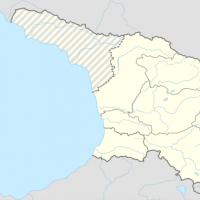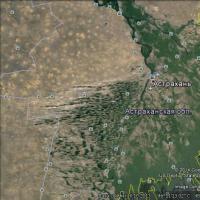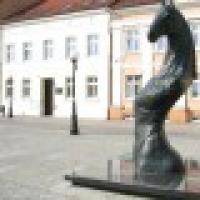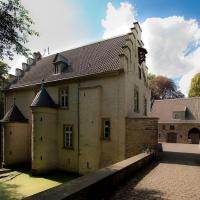Crotone: city of Pythagoras. Calabria. Open the left menu of Crotone The life of Pythagoras in Samos and the reasons for leaving for Croton
And Greece. After all, the city was founded by Greek colonists, immigrants from the Peloponnese peninsula, and in ancient times the city was inhabited by Greeks. And although many years have passed since then, the language of the inhabitants gravitates more to Greek than to Italian. However, only sophisticated linguists can catch this nuance by ear.
History of Crotone
The city was founded in 710 BC. Due to its favorable location, as well as the entrepreneurial spirit of the locals, it quickly became one of the largest and most prosperous cities of the Great Greece(as the territories of Greek settlements in southern Italy were called in antiquity).

The inhabitants of Crotone were also known in the ancient world for their excellent physical fitness (they repeatedly won Olympic Games), as well as the moderate lifestyle they led.
Prospered in the city and science. So special glory in the ancient world found medical school, and besides, in the city, medicine and mathematics were held in high esteem.
One of the most famous events in the history of the ancient world was the war of the inhabitants of Crotone with their neighbors, the Sybarites. The Sybarites were famous for their idle lifestyle. Both cities vied for hegemony in southern Italy. The case ended in a war, and a natural, as in my opinion, victory for Crotone.

In 480 B.C. the city sent warships to participate in Salamis battle. However, in the same year, the inhabitants of the city were defeated by their neighbors, and the era of the decline of the city began.

During the Second Punic War, Hannibal chose Crotone as a wintering ground for his army. In 194 BC. the city became one of the colonies of Rome. As part of the Roman Empire, it was an insignificant city. Little is known about his history from this period. And after the collapse of the Roman Empire, he shared the fate of other cities. The city, in different periods of history, was owned by different peoples. It was visited by Saracens and Normans, Spaniards and French. In 1861, Crotone became part of the unified Italy.

Attractions Crotone
Cathedral of Crotone. The city's cathedral was built in the 9th century. Like many other monumental cathedrals in Europe, the cathedral was rebuilt several times in subsequent years, and therefore its appearance contains features of several architectural styles. One of the attractions of the cathedral is the icon of the Black Madonna, which, according to legend, appeared in the city at the dawn of the Christian era.

Castle of Crotone. The castle was built in the 16th century by the Holy Roman Emperor Charles V. Today, there is a museum on the territory of the castle, where artifacts found during excavations of the ancient city are exhibited. Also noteworthy are the walls of the castle, from where beautiful views of the city and its surroundings open.

Ruins of an ancient castle. The ancient fortress of the city is located on an island, which is connected to the mainland by a small strip of land.
Crotone on the map
By clicking anywhere on our site or clicking "Accept", you agree to the use of cookies and other personal data processing technologies. You can change your privacy settings. Cookies are used by us and our trusted partners to analyze, improve and personalize your user experience on the site. In addition, these cookies are used for targeted advertising that you see both on our site and on other platforms.Useful information for tourists about Crotone in Italy - geographical location, tourist infrastructure, map, architectural features and attractions.
Crotone is a large city in the Italian region of Calabria, located on the shores of the Ionian Sea. It was founded around 710 BC. as the Greek colony of Croton. Since the Middle Ages and until 1928, the city was called Cotrone, and only in the 20s of the last century was renamed Crotone. In 1994, it became the capital of the newly created province of Crotone.
It is believed that the Greek Mycellius, who arrived here from the northern shores of the Peloponnesian Peninsula, was the founder of the city. Soon, Croton, founded by him, became one of the most prosperous cities of Magna Graecia. Its inhabitants were famous for their physical strength and moderate lifestyle. It was Croton who "supplied" many participants and winners of the Olympic Games. In 350 B.C. Pythagoras founded his famous school here, which had a significant influence on the High Council that ruled the city. In 480 B.C. Croton sent a flotilla to help the Greeks at the Battle of Salamis, but the victory of Locri and Regius (modern Reggio di Calabria) marked the beginning of a period of decline. Already in the year 379, the city was captured by the tyrant Dionysius from Syracuse, who wanted to rule all of Magna Graecia. Dionysius was replaced by another tyrant - Agathocles. When the Pyrrhic Wars broke out in Italy, Croton was still an important city with almost 20 miles of defensive walls. However, shortly thereafter, at the end of the 3rd century BC, almost half of the city was destroyed. The surviving inhabitants submitted to the Roman emperor. Throughout the history of Croton as a Roman colony, almost nothing is known about it.
Around the year 550, the city was captured by the Ostrogothic king Totila. Then it became part of the Byzantine Empire, in 870 it became a stronghold of the Saracens, and in the 11th century it was conquered by the Normans. The further history of Croton repeats the history of all southern Italy - it was part of the Kingdom of Naples, the Kingdom of the Two Sicilies and the Kingdom of Sardinia. In 1861, the city joined Italy.
The location of Crotone between the ports of Taranto and Messina, as well as the availability of hydropower to generate electricity, contributed to the rapid industrial development of the city between the two world wars. Its population doubled in the 1930s. However, in the 1980s, an economic crisis began, which forced many residents to leave the city.
Crotone has preserved a number of attractions that may be of interest to tourists. One of them is the Cathedral, built in the 9th-11th centuries, but significantly rebuilt later. Today it stands out for its neoclassical façade and baroque interior. Of particular note are the 12th-century font and the Madonna di Capo Colonna icon, which, according to legend, was brought from the East in the early years of Christianity. The castle, built in the 16th century by order of King Charles V, today houses the City Museum with exhibits introducing the history of ancient Croton. From the same period, the ruins of defensive walls and several watchtowers remain. In addition, the city has an archaeological museum, an art gallery and a provincial museum of modern art.
Crotone (Crotone, 6,000 people) is the center of the province of the same name.
The city was founded in 708 BC. e. Achaean colonists who arrived on the shores of the Ionian Sea, following the prophecies of the oracle. They also founded the cities of Caulonia, Squillache and Ternia. Regarding the appearance of the Greek name Croton, there is a very original linguistic version. Croton (castor bean) - a plant from the seeds of which castor oil is made. During the settlement of the Greeks in this area, thickets of castor beans literally surrounded the city. Later, the modern form of the name appeared - Crotone.
In ancient times, Croton was considered the city of great athletes, its athletes won prizes at the Olympic Games of Magna Graecia more than once. One of the most famous is the hero Milon (VI century BC), recognized as "the last athlete from Croton, but the first among the Greeks." Once he appeared at the Olympic stadium, carrying an adult bull on his shoulders, and kept him like that for an hour and a half. This incident glorified his name for centuries more than his military successes, and in his time he was known as the conqueror of Sibari.
In addition to sporting achievements, the city was proud of its achievements in medicine and philosophy. His most famous sons are Akmeon (or Alkmaeon), and the legendary Pythagoras. Researchers have not exactly established whether the famous philosopher-mathematician was born in Croton, but they assure that this great man lived and worked here for a long time.
Croton reached the peak of his power and glory at the beginning of the 6th century. BC. After the victory in 510 BC. e. over the Sibarians, it became the main city of Magna Graecia, more significant than Taranto (Apulia). The inhabitants of Croton received the right to mint their own coin. The heyday continued until a new colony of Turi appeared in the neighborhood of Croton. In the IV century. BC e. the city was captured by the Syracusans under the command of Dionysius I. In 295 BC. e., after the defeat of the Syracusan tyrant Agathocles, the citizens of Croton were forced to turn to Rome for help. The last impetus to the final decline was the long siege of the city by the troops of Hannibal.
In the Middle Ages, Crotone was alternately owned by the Byzantines and the Normans. Under the Angevins, it received the status of a royal city, but at the same time remained a subject of contention between several feudal clans. In the end, representatives of the Ruffo family gained the advantage. Despite all the historical troubles, Crotone has not lost its strategic and economic position, largely due to its favorable geographical position and excellent seaport.
Today Crotone is a modern city with developed infrastructure. Its port serves fishing, cargo and passenger ships. The only harbor on the Ionian coast for mooring large-tonnage ships was built here. The harbor and the newly opened airport have allowed a sharp increase in the influx of tourists.
Of the material evidence of the former greatness of the main city of Magna Graecia, little has been preserved. The fact is that in 1541, the viceroy of Naples, Pedro of Toledo, started a large-scale construction in Croton, during which the acropolis and many other ancient monuments perished, but the city received new defensive fortifications and the Great Castle. Historical treasures discovered at the site of ancient Crotone in the course of recent archaeological research have been transferred to the Archaeological Museum.
It is best to start acquaintance with the central part of Crotone from its heart - Pythagoras Square (Piazza Pifagor), which connects the historical core with modern quarters. From Pythagoras Square there is a noisy Vittoria Street (Via Vittoria), but before you go to Duomo Square (Piazza Duomo), it is better to walk along Veneto Vittorio Emmanuele II Street (Via Veneto Vittorio Emmanuele II) to the old town hall and Immacolata Church (Chiesa della Immacolata). ). The latter is a single-nave structure, decorated with bizarre paintings. The Cathedral (Duomo) of Santa Maria Assunta rises on the square of the same name. It was first built in the 16th century and restored in the 17th century. The facade of the XIX century is made in the neoclassical style and was built in three stages. Inside the building is divided by columns into three naves. Nearby, in the Privilegiata chapel (Capella Privilegiata), there is a true treasure - the Byzantine-style icon "Madonna di Capo Column", brought from the East in the 19th century.


Crotone
Crotone was founded in 708 BC. e. Greeks who landed on the shores of the Ionian Sea in the place where the Delphic oracle indicated to them. The name of the city is quite interesting: in Greek, the word "croton" means "castor bean" - a plant from the seeds of which castor oil is made. Most likely, in those distant times, these places abounded with thickets of castor beans, which, however, are still enough today.
Today Crotone is a small but modern city with a well-developed infrastructure. The only harbor on the Ionian coast of Italy for mooring ships was built here. The newly opened airport has also increased the flow of tourists to these places.
How to get there
Crotone has its own airport, which bears the name of St. Anne. True, it is mostly used for domestic charter flights, but you can fly here from Rome without any problems. There is also a railway station in Crotone that receives trains from Naples, Reggio di Calabria and other cities of the country.
Search for flights to Crotone (nearest airport to Crotone)
Beaches
Paid and free beaches of Crotone can be easily found along the ever-humming embankments via Cristoforo Colombo and viale Gramsci. It is full of bars, restaurants and cafes for every taste, shops and souvenir shops are open, in the evenings an elegant motley crowd of tourists hustle.
Popular hotels in Crotone
Wine from Crotone
Near Crotone is the world-famous place among wine connoisseurs Ciro, where Ciro, Melissa, Librandi and other wines are produced. According to the legend, it was Ciro wine that served as a reward for Olympic athletes. Going there for a tasting is a special pleasure among vacationers in Crotone. The lazy ones can be advised to look into one of the city's wineries to buy a bottle or two of the famous grapevine drink. For example, in the wine cellar Marino (Via Nicoletta, 3), where there are about 800 types of wine, or in Squillace Vincenzo (Via Venezia, 80), where the owner gladly gives table wine tasting from huge barrels.
Entertainment and attractions in Crotone
Walking through the old Crotone is best to start from Piazza Pythagoras, from where the noisy and cheerful Via Vittoria originates - it will lead you to Duomo Square. Here, wherever you look, you will find an attraction.
For example, the Church of the Virgin (Chiesa della Immacolata, 1500), whose neoclassical facade is intricately decorated with elegant paintings. Nearby is the main cathedral of the city in honor of St. Mary of Asunta of the 16th century. In the neighborhood there is a chapel (Capella Privilegiata), where there is an amazing Byzantine icon of the Madonna di Capo Column, the so-called "Black Madonna". She was brought to Crotone in the 19th century. from Palestine. Since then, every May 30, a solemn mass is served in honor of the icon and a holiday is organized.
Walking through the old Crotone is best to start from Piazza Pythagoras, from where the noisy and cheerful Via Vittoria originates - it will lead you to Duomo Square.
There are other religious buildings in Croton that are definitely worth a visit. For example, the Baroque Cathedral of St. Giuseppe built in 1719, which is notable for its marble altar and wooden statues of the saint in whose honor the temple was consecrated, as well as St. Gregory and Nicholas the Wonderworker. Next is the church and monastery of St. Chiara, founded in 1400. Frescoes of the early 18th century are interesting here, as well as a handmade floor in the style of Neapolitan majolica. Finally, the church of St. Peter and Paul from 1460, which today, alas, is in poor condition (because of the earthquake of 1783).
One of the favorite sights of Crotone among tourists is, of course, the castle of Charles V built in 840 (heritage of the Saracens). Directly, Charles took up the castle in the 16th century, ordering to rebuild and strengthen it. Today it houses the Archaeological Museum (Via Risorgimento, 120; opening hours 9:00-19:00).
10 km from Crotone, on the picturesque cape of Capo Colonna, there are the ruins of the largest temple of Magna Graecia, or rather, the only Doric column that remained of it. The temple, named after the queen of heaven, Hera Lacinia, dates back to the 6th century. BC e.
- Where to stay: look for secluded small bays with azure water in Maratea, landscapes unique for Europe with citrons - in Praia a Mare, developed infrastructure - in Scalea, "painted" walls of houses by famous masters - in Diamante, active and sports tourists should opt for Vibo Valentia, well, those who are eager for ancient monuments will certainly be interested
 Consider each of the requirements for metal detectors
Consider each of the requirements for metal detectors Metal detector in an educational institution
Metal detector in an educational institution How to wipe the TV screen at home
How to wipe the TV screen at home Senaki mikha tskhakaya. Mikha tskhakaya. Notable residents of the city
Senaki mikha tskhakaya. Mikha tskhakaya. Notable residents of the city International Journal of Applied and Basic Research Volgo-Caspian Shipping Canal Main Bank
International Journal of Applied and Basic Research Volgo-Caspian Shipping Canal Main Bank How to deal with sunburn if you are burned
How to deal with sunburn if you are burned Hagen, Germany: why go, what to do, where to eat, travel tips Where and what to eat and drink in Hagen
Hagen, Germany: why go, what to do, where to eat, travel tips Where and what to eat and drink in Hagen